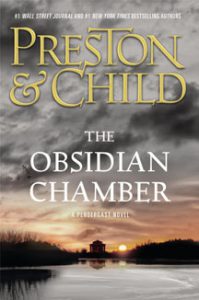For the first 100 pages of “The Obsidian Chamber” (October 2016, hardcover), Douglas Preston and Lincoln Child’s 16th Agent Pendergast novel, one word kept popping into my head: “crazy.” In almost a parody of their most credulity-pushing excesses from the Gideon Crew books, Pendergast’s butler Proctor chases Constance and her kidnapper all over the globe.
In a matter of mere days, he’s trekking across the Kalahari Desert in Africa and fighting off lions. The prose has a numb, relentless quality, but it’s still insane.
Personal mysteries
I breathed a sigh of relief as “The Obsidian Chamber” settles down into a more recognizable Pendergast novel, except with the mysteries playing out on an unusually personal level, with unorthodox points-of-view allowing for surprising insights into our favorite characters. In the back of my mind, I knew the authors had to resolve that bizarre Proctor prologue, but I didn’t totally care if they forgot about it.

“The Obsidian Chamber” (2016)
Authors: Douglas Preston & Lincoln Child
Genres: Mystery, thriller
Series: Agent Pendergast No. 16
Settings: Africa, New York City, Florida Keys
There’s no way to talk further about this book without revealing some twists, so I’ll put a SPOILER WARNING here.
This is the best novel so far about Constance Greene, Pendergast’s ward who looks 20-something but is a century older. Interestingly, we get insight into her mindset through a backdoor.
Diogenes, Aloysius Pendergast’s brother who was supposedly killed off in “The Book of the Dead,” is back; we suspected as much from hints in “Crimson Shore.” He courts Constance, his former lover whom he was merely using for the sake of revenge on Aloysius. But he claims to truly love her now. In a twist, she submits to his advances.
Diogenes’ POV
The cool thing about how P&C write this relationship is that it’s mostly from Diogenes’ perspective, so we know he really has changed and that he does indeed love Constance. Constance is a cipher, so readers (particularly male readers) feel a kinship with Diogenes as he tries to figure out the mystery of what this woman actually feels for him.
This is despite the fact that Diogenes is undeniably the villain of the series, having logged a massive murder count; he adds to it even in this book, and that’s to say nothing of the mortal danger he puts Proctor in, just for the sake of getting him out of the way.
Even less of a surprise than Diogenes’ resurrection is that of Pendergast himself. Again keeping things fresh with an unorthodox POV, we follow the seafaring ransom-seekers who pulled the agent from the Atlantic Ocean, where he was left drifting at the end of “Crimson Shore.” We also get the FBI’s perspective – particularly that of Pendergast’s former Army mate, Longstreet — as it seeks to retrieve our main character.
Flavia flavor
Although not many pages are devoted to a possible Pendergast-Constance romance, the final pages advance this thread, which was introduced in “Crimson Shore.” Pendergast is in his 40s and Constance is by appearance in her 20s – but actually in her 140s; oddly, while Pendergast cares little for societal propriety as an investigator, propriety keeps him from a romance with his ward. I have no clue if P&C will bring them together in a future book, but it’s something to keep us guessing.

Possibly the most interesting character, though, is Flavia (again, a “Crimson Shore” holdover, although you’d be forgiven if you forgot about her). She sees Diogenes as her soulmate in sociopathy. If the axiom that “If you don’t see a dead body, the character is still alive” holds true, we’ll see her again, and I’m hoping the Flavia-Diogenes story has more meat on its bones.
The craziness of those first 100 pages does pop up again as the book moves forward, particularly when Diogenes uses one of his several carefully cultivated fake identities to both administer lethal drugs to a Florida death-row inmate AND to perform the autopsy (which allows him to extract a part of the spinal column crucial to the formula that stabilizes Constance’s aging, a nod to the monster’s need for hypothalamus glands back in “Relic”).
Stretching reality
“The Obsidian Chamber” doesn’t have quite as much of a sense of place as other P&C books, largely because there’s so much globe-hopping, but Diogenes’ island in the Florida Keys makes for a beautiful home base for the late-stage action. The titular structure doesn’t play as big a part as one would think, although it is the site of one notably racy scene.
Ultimately, “The Obsidian Chamber” stretches its tether to reality further than any previous Pendergast book. But at the same time, it’s one of the elite character-oriented tomes in the series, providing insight and background information into Pendergast, Constance and Diogenes.
It ends on a period, whereas “Crimson Shore” ended on an ellipses, but I suspect the relationships among these three characters will be revisited, possibly as soon as the next book.

